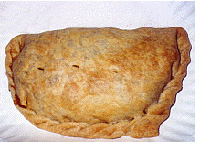

|
Cornish Pasties |
|---|
|
The pasty is a symbol of Cornwall, England. Some Cornish families can trace their ancestry through their pasty recipes. No one knows for sure whether the Cornish invented the pasty, or whether they picked it up from some other group. Some think that the Vikings may have brought the pasty to the British Isles when they invaded. Another tradition is that it was derived from the Italian pasta, since the Cornish were known to be skilled seamen. But the first written references to the pasty attributes it to the region of Cornwall, England. |
|
The pasty became a staple of Cornish miners for many reasons. The traditional pasty was a complete meal in itself, consisting of meat, potatoes, onion, and seasoning, all wrapped in a bread crust. A miner who left home with a hot pasty in his pocket could reach in every now and then to warm his hands. Also importantly, the tin mines contained arsenic and, with the pasty, an advantage was that the miner could hold the pasty by its thick crust, throwing it away after the body of the pasty was eaten. |
|
The Cornish pasty has become commercialized in Cornwall, England. With a market unprepared to pay the price of a decent pasty, it has been flooded with cheap pasties for a mass tourist market. |

Copyright(c) 2002,
2003, 2004 Ken Anderson. All rights reserved.
kenanderson@kenanderson.net






